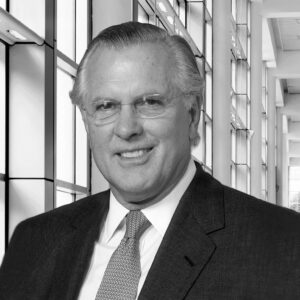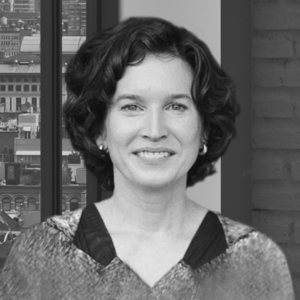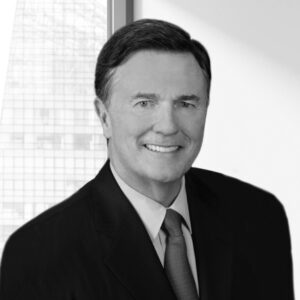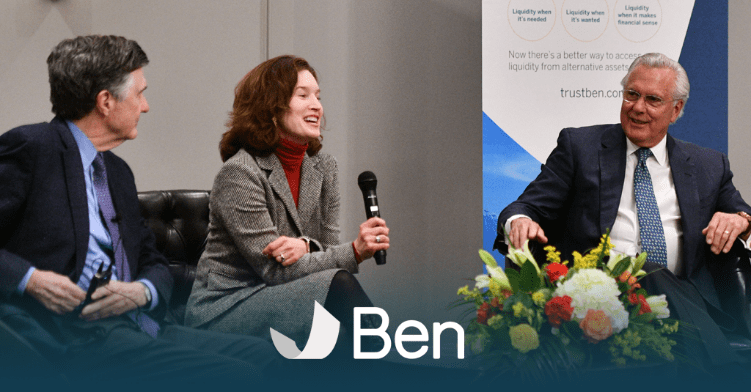As the U.S. Federal Reserve Board continues its program of raising interest rates, the U.S. economy may be heading for a soft landing, a hard landing, or maybe no landing at all.
“We may be hovering above the landscape,” former Dallas Federal Reserve Bank President Richard Fisher told attendees at a dinner hosted by Beneficient in Topeka, KS.
It was a rare opportunity to hear from two former Federal Reserve Presidents. Fisher was joined by Dennis Lockhart, former President of the Atlanta Federal Reserve Bank. In a session moderated by Beneficient Board of Directors member Emily Bowersock Hill, the CEO of Lawrence, KS-based Bowersock Capital Partners, Fisher and Lockhart provided insights into the process the Fed uses to determine interest rates and guide the economy. Fisher and Lockhart are also members of Beneficient’s Board of Directors and both served as Federal Reserve Presidents during the last major economic crisis, the Great Recession of 2008-2009.
Inflation: The Horse is Out of the Barn
The current issue facing the Fed is taming inflation, which reached an 8.5% annual rate last year following the Covid-19 pandemic. For a time, the Fed’s strategy was based on an academic argument to tolerate “transitory” inflation as the economy was allowed to run “hot” as it returned to the previous environment of sub-par growth with high unemployment. Under that approach, any inflation was believed to be caused by temporary supply chain disruptions, Lockhart said.
“It was a historic mistake,” Fisher said.
Fisher described the current situation in Kansas terms: “The problem is that when you let the inflation horse out of the barn you have to find it in some distant pasture and you have to corral it and bring it back,” Fisher said. “It’s very hard to accept that an inflationary impulse is going to be transitory. The question is how long is the transition?
“I think the Fed is working very hard, having moved very quickly to make sure they don’t make two mistakes in a row.”
The Fed’s Bold, Data-Driven Mission has Evolved
The two former Fed Presidents gave a fascinating description of how the Fed operates and what’s next for the economy. The Fed’s challenge is akin to flying a plane in the dark where only half of the dashboard instruments work. “And you’re not sure which half,” Lockhart said.
“It’s a data dependent process but you’re always looking in the rear-view mirror,” Lockhart said. “It is a process in which everyone has a say. Richard and I representing parts of the country would share anecdotal information from our conversations with business leaders and community leaders. For weeks we are talking to people and asking them ‘how you are experiencing the current economy?’.”
To get around delayed economic data and the “noise in the system,” Fisher used a list of 30 company contacts around the country he could reach out to for real-time economic trends during his ten years on the Fed Board. The individuals on his list ranged from CEOs at companies like Exxon to small businesses that included a dry cleaner. That approach informed Fisher’s contrarian stance at Fed meetings. Notably, he sounded the alarm about a housing crisis two years before it played a central role in triggering the Great Recession. And, Fisher was a critic of the Fed’s Quantitative Easing policy that he believes went on too long.
“You had to do it in order to rescue the economy and, in my view, the global financial system. The issue was holding it for too long, in my view, so we have an entire generation, anybody who’s been in the investment community under the age of 45 who, until recently, had only experienced zero-cost money and no inflation.”
In this era of free-flowing money, investments by venture capital in technology companies thrived and the market rose. Tightening the money supply and raising interest rates will lead to volatility “until we get back to the fact of realizing that money costs money and we don’t have zero inflation anymore,” Fisher said.
Fostering Collaboration and the Legacy of the Fed
As much as the Fed Presidents take sides on the policies, both men said that there are not arguments at the regular Fed meetings. “You are just presenting what you think is the right thing to do,” Fisher said.
“It’s not a dictatorship in any way, even though you often read in the press that Jay Powell or Janet Yellin or Ben Bernanke is going to do this or that. The reality is they have to lead the group to a consensus decision,” Lockhart said. “It’s not a process to get to a perfect consensus, it’s a process to get to a decision.”
Both men were critical of the movement to get rid of the Fed, a political position that gets promoted frequently in frustration over the economy and the central bank’s control of it.
“We just don’t live in a world where you can just have a void of institutional leadership around something as important as how the U.S economy operates and generates jobs,” Lockhart said. “The only thing worse than having the Fed try to manage the economy is having no one manage the economy.”
“Or have Congress try and manage the economy,” Fisher chimed in.

Richard W. Fisher – Senior Partner Director

Emily Bowersock Hill – Director

Dennis P. Lockhart – Director
Beneficient Board of Directors members Richard Fisher, Dennis Lockhart, and Emily Bowersock Hill.

